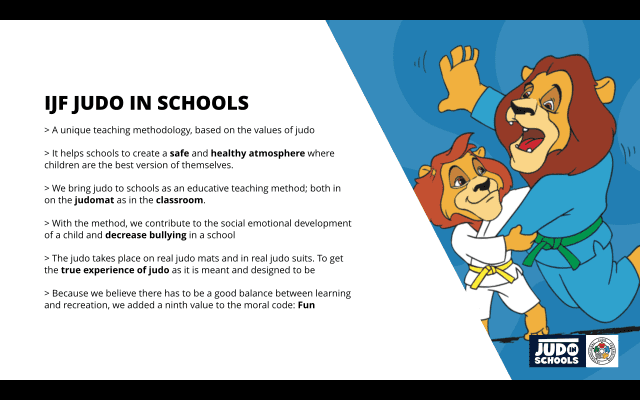Marketing and communication
Marketing and communication is a vital area for judo as a sport. The same holds true for the Judo in Schools programmes that will be set up and organised by the federation. The values and social importance of judo can be spread perfectly through Judo in Schools programmes. Not only to national organisations, who are partly responsible for funding, but also to the children’s parents, teachers and relatives who play important roles.
A youth judo programme can be a fantastic marketing instrument for judo in general.
Be aware of the fact that marketing and communicating the programme and its content are crucially important. We will highlight two significant pillars: general program communication and communication aimed specifically at the program.
General Programme Communication
The first is the general programme communication at a national and regional level. The message of a program is more than just teaching judo. The International Judo Federation has chosen 'Building better societies' as the theme of its Judo in Schools programme.
A specific national policy may demand a connecting marketing and communication message. If this is the case, it is important to show the intrinsic values, which are part and parcel of your marketing and communication activities.
Therefore, you should make sure that:
- the objective of the programme is described clearly
- you formulate a communicative message
- there is a number of keywords that invariably turn up in interviews and press releases
- you draw up a communications plan: when will you communicate with certain people? - if possible, ask a national top judoka to underline your message
Below this article, you can find an example of a way to do this: A presentation that explains the educational value of the sport and what it means to have this program in schools.
Communication aimed specifically at the programme The second pillar is the communication aimed specifically at the programme. This mainly takes place at a local level and is aimed at the participants and their relatives. Experience shows that in 90% of cases the parents play a decisive role in the decision whether or not a child may take up a sport and if so, which sport.
Therefore, it is very important to involve the parents by means of communication. When parents see how much fun judo has to offer their children and when they realise what values their children learn, there is a far greater chance that the children will stick with judo for a much longer period or that they may even join a local club. Therefore, the parents should be informed clearly about the Judo in Schools programme and the possibilities of their children joining a club after having taken part in a programme. Make sure to plan a moment in the programme to invite parents to a big judo demonstration party (this will also attract the attention of the media). This will increase your chances of success and add to the numbers of new members.
Below you can find an example of such a big judo demonstration party in the Netherlands.
Press and media (earned media) Press and other media also play a very important role in the execution of the youth judo programmes. The federation itself will have to stimulate contacts with press and other media in order to get the desired media attention. We advise you to focus on pointing out the values of the programme and of judo in general. We do not only teach judo, as we also provide skills for life through the programme. As the programme continues to grow, the appreciation of it in press and media circles will begin to increase. National top judokas will be able to strengthen this appreciation by adding extra value. Inviting dignitaries will also attract media and press attention. Make sure to keep up the communication process, not only at the beginning of the programme, but also during and after the programme. Write the content for the articles yourself and supply photos to support the text. Distribute these materials widely among national, local and offline media, so that they reach a broad field and thus increase the chance of publication and growing attention. We distinguish between the following stages of communication with the press:
Communication at the start → announcement of the contents of the programme and our aims.
Communication during the project → articles concerning the numbers of participants, the importance of judo, interviews with judo trainer, form teacher or national judo hero.
Communication after the project → Programmes that are about to close should be wound up in way that is attractive to the media. Invite parents and national judo heroes to an end of project party for children to remember.
Make sure you provide the media with good articles and clear pictures showing laughing children. See to it that all texts contain the two main added values offered by judo as a sport and the programme in question.
Your own media (owned media) Besides making use of free publicity, we also recommend to make good use of your own media. You could think of:
- A website for the programme, take www.schooljudo.nl as an example.
- Brochures/ flyers/posters. Purely as means of source of information on the project.
- Twitter/Facebook/Instagram and other social media. Aim at interaction with participants, fans and followers.
Make sure that when you start using your own media, that you make a content plan. What is the story you want to tell and who is your target group? What media channel fits with that message and group? Will you set up special marketing activities, for example a competition like Throw To Tokyo?
The Children Commission supports you with promotion material and regularly writes news messages about Judo in Schools programs.
The JFC commission could fill pages with opportunities for marketing and communication. We are pleased to assist you in formulating and developing the marketing and communication plan. Moreover, the commission has a selection of materials available that can be adapted to every country. Think of logo’s, diplomas and posters. Check the communication materials section for these materials.

